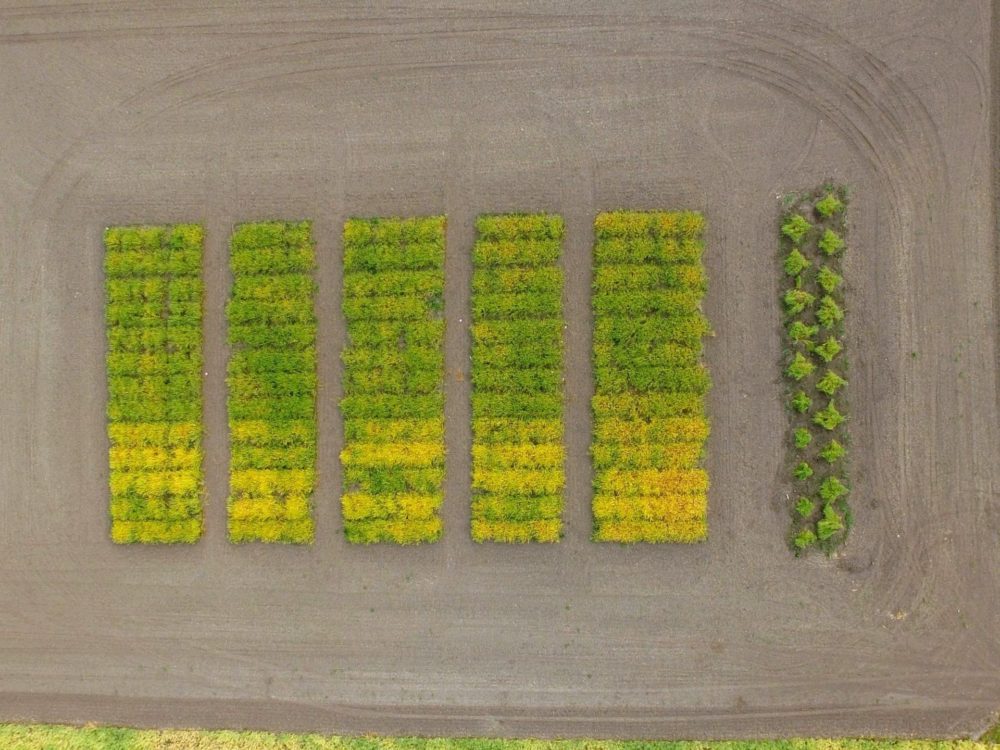Regenerative agriculture is a growing movement. It’s popping up in new places including campaign platforms, proposed federal legislation, and new grant opportunities. Despite its momentum, the exact contours of regenerative agriculture are still up for debate. Even among proponents of the movement, there are debates about the best ways to prove regenerative agriculture’s promise or the proper tools for achieving its goals. There are also question marks around the scalability of regenerative agriculture practices, which aim to build soil health, improve water quality, promote biodiversity, integrate cropping and livestock systems, and more, by cultivating a more collaborative relationship with nature.
By comparison, conventional farming practices, that often involves genetically modified crops in countries like the US, have proven very scalable. The conventional, biotech-backed model largely aims to battle nature, by developing crops able to withstand stressors like weather, diseases, and, unfavorably, pest-killing chemicals, and typically focuses on growing just one or two crop types a year.
The link between biotech and conventional farming will no doubt cause many regenerative agriculture purists to balk at the idea of these tools being applicable to their innately more diversified and often chemical-free approach. But bearing in mind the question marks around its scalability, could genetic technologies be a useful tool in the regenerative agriculture toolbox too?
At least one innovator thinks so.
Oliver Peoples is CEO of Yield10 Bioscience a gene-editing startup that started looking at camelina as an alternative to wheat for growers in the Pacific Northwest and Saskatchewan areas.
“As we became more knowledgeable about the ag space, we realized that it was very tough for a company regardless of its size to compete with major crops because of consolidation like soybeans, corn, canola, cotton, and rice. Ultimately, you are a licensor of tech to that sector,” Peoples tells AFN.
Then Peoples realized camelina’s potential as a winter cover crop.
“Camelina sativa seeds produce an oil that is equivalent to omega-3 long-chain polyunsaturated fatty acids seen in fish oils. Demand for these oils is increasing as we aim to feed a growing population – a 2015 Scientific Reports study noted that approximately 1.25 million metric tons of omega-3 oils will be needed to feed a population of 7 billion people. Plant-based oils, like those from Camelina seeds, can be used as a less expensive, sustainable option to supplement fish oil in feed for aquaculture,” he explained.
By using gene-editing to improve yields, farmers can yield more seeds and produce more oils, thereby increasing their potential for a decent paycheck from this regenerative practice, says Peoples.
Gene-editing cover crops
Cover cropping is a key practice adopted by regenerative farmers between growing seasons to keep the soil covered and protected from erosion or run-off, as well as to help replenish minerals and maintain healthy soil structure through the constant presence of a root system.
At least one other startup is working on developing cover crops for farmers that double as an extra cash crop. CoverCress is developing a winter cover crop from the native plant pennycress using modern plant breeding and new genome editing tools, for example.
To bolster his point, Peoples and Yield10 point to the recently released Forum of the Future report that lays out a seven-point system for shifting our current food system to reflect regenerative agriculture principles. The points involve establishing financial mechanisms and market structures that support regenerative outcomes like shaping new policy, engaging with consumers to increase demand, and prioritizing nutritional benefits. Produced with funding from the Walmart Foundation, the report also identifies 16 barriers to scaling regenerative agriculture. The report does not mention CRISPR or gene-editing techniques, but according to Yield10, it ticks many of these boxes already.
“Biotech is one very important piece of the larger solution for developing regenerative agriculture which allows farmers to increase revenue. Biotech, and genome editing tools like CRISPR can accelerate the breeding of new crops and crop varieties, which create new markets and make farming practices more sustainable by emphasizing traits that boost yield, nutrition, composition,” Peoples explains. “As COVID 19 is reminding us we need to develop technology solutions at an accelerated pace so farmers adjust to climate change, soil degradation, and new pests. Genetic engineering tools including CRISPR will help us create crops that are resilient, higher-yielding, and healthier using the resources that we have. Ultimately, this will keep us on target to meet sustainable food security demands for the growing population.”
Do successful ends justify the biotech means?
But for those in regenerative agriculture that view the movement as a return to the simpler farming methods of the past, including gene-editing could be a non-starter.
“We should be open to all technologies that can make a difference and accelerate good agriculture practices. But, we need to have a high bar on the actual changes implemented and understand their full impacts – both direct and indirect,” Lew Moorman, a Scaleworks co-founder Lew Moorman wrote to AFN via email. Scaleworks recently launched a new regenerative ag-focused investment fund called Soilworks Natural Capital. It made its debut by acquiring grazing management software platform PastureMap.
For Moorman, allowing biotech or any other technology into the regenerative ag movement will require some careful gatekeeping along with honest and thorough explorations into the full consequences of each technology. Regenerative agriculture is less about the outcome and more about the system as a whole, afterall.
“The concern I would have is are we going to use these technologies to just deal with symptoms not underlying issues. The core problem with GMOs is they are used often to ensure more chemical durability. Well, this just does not address the real problem which is poor soil and ecosystem health.”
Others are agnostic about the methods chosen for achieving regenerative agriculture’s goals.
“As long as it has a positive effect on biodiversity, soil regeneration, and water resilience, it’s perfectly fine,” Felipe Villela, founder of regenerative agroforestry-focused reNature and lead author at UN Environment, wrote to AFN via email. “We saw that the Green Revolution had caused a collapse in land, degradation, and biodiversity loss. If used in favor of nature and regeneration, it’s definitely welcome. We can’t exclude any type of tech that can boost the potential of crops that will feed us in the future.”
Villela also points out that technology in general will be crucial for scaling regenerative agriculture for a number of reasons. Reinventing machinery that poses less soil disturbance and coming up with new strategies to help farmers handle the increased intensity that comes with more diversified operations are two examples he poses. He also sees a major opportunity among emerging carbon markets like Nori.
Generational impact
Younger generations are proving to be a powerful contingent in the bid for gene-edited foods, he adds. Members of Gen Z – born between 1995 and 2010 – are the most willing to try foods produced with gene editing technologies, according to a 2019 study. Sixty-seven percent of millennials and 58% of Gen Xers were also willing to opt for innovative food compared to 58% of baby boomers.
But other data suggest that consumers are vehemently opposed to using technology to alter our food. The Washington Post ran an opinion piece by Purdue University’s president in which he extolled the virtues of genetically modified crops and described their prohibition as immoral. The post generated over 1,600 comments in two days. Many of the remarks reflected anger, sarcasm, and a lack of awareness about these technologies, according to Agri-Pulse.
Public skepticism over GMOs eventually led to the passage of a federal law requiring foods produced with bioengineering to bear a label. This has led many stakeholders in the gene-editing industry to encourage a different approach to outreach and education about CRISPR.
For Peoples, criticisms against gene-editing are often misplaced. It can be all too easy for people living in coastal cities and metropolitan areas to become completely disconnected from food production and equally as arrogant in dictating how farming should be done while sitting in an air-conditioned office, he says.
“I think what I have seen among the ultra-organic camp is that it’s more like a cult or religion. I dealt with them in a past business in a dispute over the use of sugar from a GMO crop to make a natural, biodegradable product,” Peoples explains. “I don’t think there is much we can do about that segment. Some people ignore science and are fundamentally opposed.”
The pandemic adds a new layer to the ongoing dialogue about regenerative agriculture and gene editing, however; it may be too soon to determine how the pandemic may impact either.
“There is some upside. The world is waking up in a pandemic and realizing things can get bad very quickly. Most of my generation, millennials, and Gen X have never gone to the grocery store and seen empty shelves or freezer cases, so in some ways, it’s been a massive wake up call. There is more of a global consensus around climate change and its impact on food production.”
Although it is easy to get bogged down in the complexities of debating whether biotech should be embraced within regenerative agriculture, perhaps it is important to remember one of the foundational guiding principles of the movement; that the one-size-fits-all, plug-and-play approach of conventional agriculture to cultivating food, which sees variability as a threat to efficiency, has led to a lot of problems in our food system. Regenerative agriculture instead encourages us to embrace the nuances that exist region to region, state to state, county to county and to opt for bespoke management instead of simply getting big or getting out.
Maybe the debate over whether biotechnology is appropriate should be left to the same case-by-case adjudication, too.
















Sponsored
International Fresh Produce Association launches year 3 of its produce accelerator